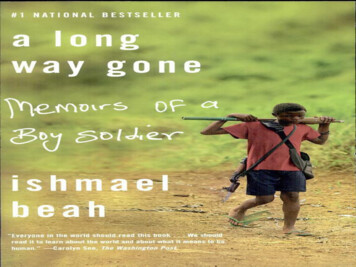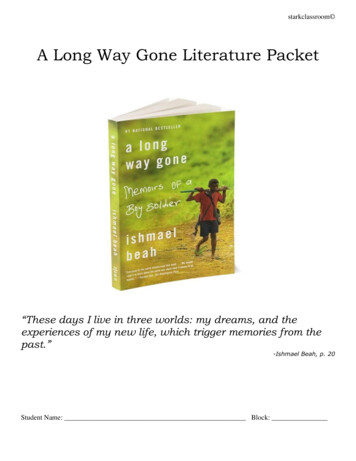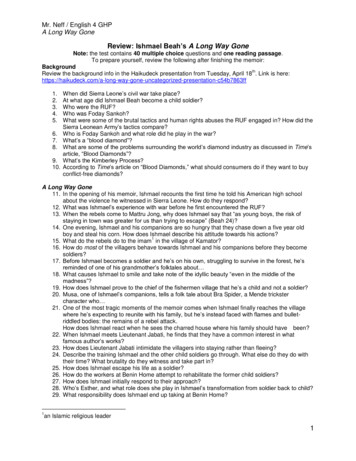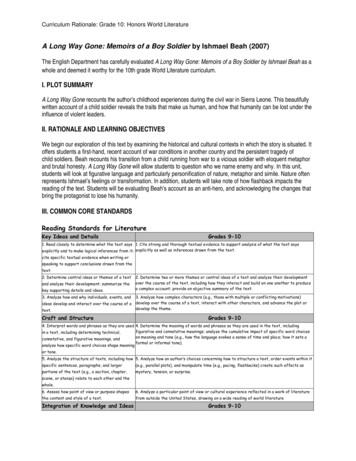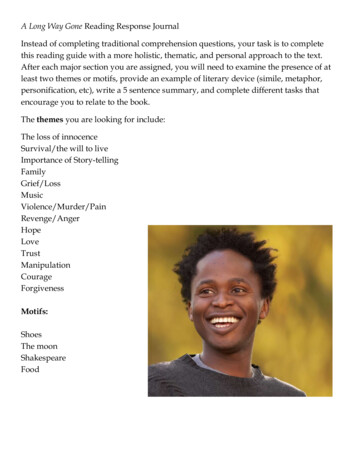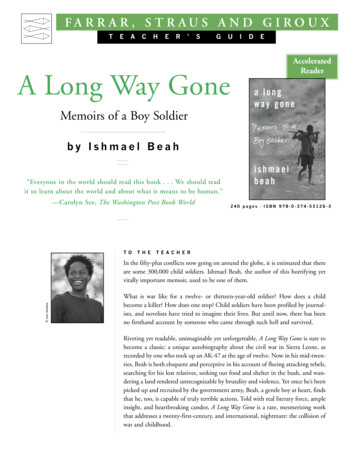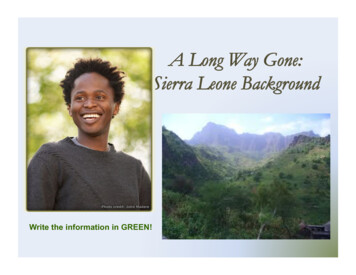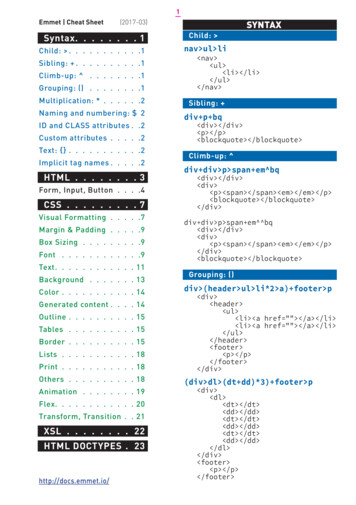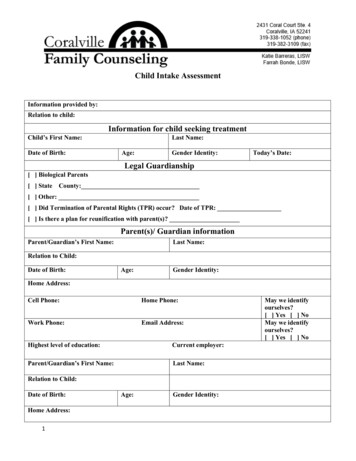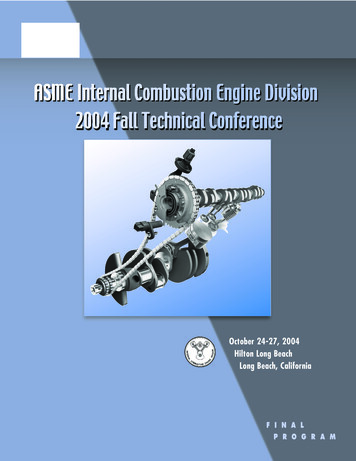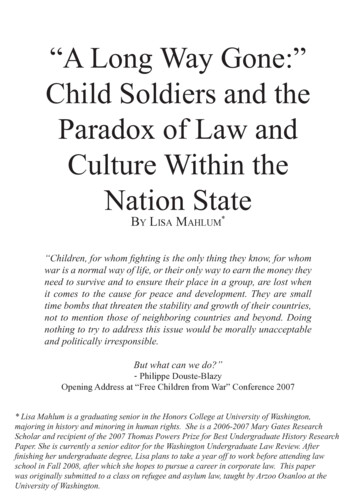
Transcription
“A Long Way Gone:”Child Soldiers and theParadox of Law andCulture Within theNation StateBy Lisa Mahlum*“Children, for whom fighting is the only thing they know, for whomwar is a normal way of life, or their only way to earn the money theyneed to survive and to ensure their place in a group, are lost whenit comes to the cause for peace and development. They are smalltime bombs that threaten the stability and growth of their countries,not to mention those of neighboring countries and beyond. Doingnothing to try to address this issue would be morally unacceptableand politically irresponsible.But what can we do?”- Philippe Douste-BlazyOpening Address at “Free Children from War” Conference 2007* Lisa Mahlum is a graduating senior in the Honors College at University of Washington,majoring in history and minoring in human rights. She is a 2006-2007 Mary Gates ResearchScholar and recipient of the 2007 Thomas Powers Prize for Best Undergraduate History ResearchPaper. She is currently a senior editor for the Washington Undergraduate Law Review. Afterfinishing her undergraduate degree, Lisa plans to take a year off to work before attending lawschool in Fall 2008, after which she hopes to pursue a career in corporate law. This paperwas originally submitted to a class on refugee and asylum law, taught by Arzoo Osanloo at theUniversity of Washington.
46Washington Undergraduate Law Review Vol I, Issue 1 Spring 2007Introduction 46I. International Discourse on Children’s Rights and the Efforts to Protect theRights of Child Soldiers 47II. A Case Study of Ishmael Beah within the Context of Law, Culture, andthe Nation State 52Conclusion 57IntroductionIn our modern world where international advocacy for human rightsprotection has arguably reached its historical zenith, a category of children hasemerged whose rights are systematically obliterated through violent participationin child warfare. According to the February 2007 “Paris Principles,” which is themost recent international document against children’s involvement in war, “a childassociated with an armed force or group refers to any person below 18 years of agewho is or has been recruited or used by an armed force or group in any capacity,including but not limited to, children used as a fighters, cooks, porters, messengers,spies, or for sexual purposes.” The most recent estimates made by UNICEF in2006 projected that there were 250,000 to 300,000 children fighting as soldiersfor causes that bring little if any peace to the alleged conflict. Despite internationalprotocols that render child warfare illegal, hundreds of thousands of children findthemselves without the needed protection from the state, which consequentlysubjects them to forced armament. How have children become so overlooked bythe nation state that they become exploited at such a large scale? Why are childrenforced to surrender their childhood to illegally and prematurely assume adultresponsibilities of becoming coerced soldiers?The nation state, as a sovereign body and guarantor of human rights, issupposed to be the arbiter between the cultural and legal realms of society ensuringthat one realm does not infringe upon the expression of the other. In nations wherechild warfare exists, the cultural norms amongst social groups that mandate theuse of child soldiers eclipse the legal codes of national and international law thatprotect children from forced armament. Betrayed by their nation state, child soldiersfind themselves without legal protection and are consequently summoned to adhereto their country’s cultural standards of necessary wartime conduct despite legal UNICEF Free Children From War Conference, Feb. 5-6, 2007, Paris, Paris Principles, Definition 2.1. UNICEF Free Children From War Conference, Feb. 5-6, 2007, Paris, Program Agenda, 2.
Mahlum47protocols that render child warfare illegal. This paper will use the account of IshmaelBeah, a rehabilitated child soldier from Sierra Leone, to reveal the process throughwhich the nation state fails to protect the legal rights of children thereby forcingthem into violating situations of child warfare. By placing the case of Ishmael Beahwithin the legal and cultural framework of international children’s rights, this paperwill explore the disparity that rests with the nation-state’s ability to protect youthcaught between the legal world of innocent childhood and the cultural world ofmilitant adulthood.I: International Discourse on Children’s Rights and the Efforts to Protect theRights of Child SoldiersWith the emergence of the nation state dating back to the Treaties of Westphaliain 1648, people have since been enamored with the idea of state sovereignty basedupon territorial borders and personal sovereignty based upon citizenship withinan established nation state. As the wheels of modernity inspired a proliferation ofrevolutions in the 17th and 18th centuries, people became increasingly tied to theidea of personal rights based upon secular ideals of intrinsic humanness instead ofreligious ideals of God’s ‘natural’ hierarchy. Living in a world where the sovereignnation state defines the essence of international law, people have synonymouslylinked democracy with personal liberty and have interpreted the nation state as thealmighty enabler of these precious things we now call “human rights.” However,human rights themselves are not at all human; they are political rights engenderedto protect the physical safety of one’s life and to allow for the freedom for one tocontrol his or her own life without fear or actual threat of persecution.Even though the concept of “inalienable” human rights suggests that manwas the source as well as ultimate goal of human rights , they remain a product of thenation state’s polity and are only theoretically grounded in a philosophical conceptof humanity. Rights only exist as long as someone is willing to grant them; the onlyway human rights gain any sort of legal ramifications is for a governing nation stateto take responsibility for protecting its citizens against persecution. Without legaland political backing by the nation state, human rights (as internationally recognizedin the UDHR) have no legal enforceability —they are simply a statement of utopianideals recognized by drafters as a hopeful goal. In the case of the modern world, thenation state becomes the source for rights whereby members of the state are granted Hannah Arendt, The Decline of the Nation-State and the End of the Rights of Man, in The Origins of Totalitarianism 291(Schocken Books 1966) (1951). Mary Ann Glendon, A World Made New Eleanor Roosevelt and the Universal Declaration of Human Rights (RandomHouse 1st ed. 2001).
48Washington Undergraduate Law Review Vol I, Issue 1 Spring 2007protection from the state “against the sovereignty of the state.” In other words,the very body that grants human rights is the same body against which protectionis granted. But what happens when children, who are legal citizens without legalresponsibility, fail to get protection from the state against the harm of the state? Insome states, these children suffer rights violations and become enslaved as childsoldiers.Ever since children were written into Article 25 of the 1948 UniversalDeclaration of Human Rights (UDHR) as a specific social group that deserved“social protection” for the maintenance of a “standard of living adequate for thehealth and well-being of himself,” children’s rights have become a particularlychallenging component of international discourse as legislators, politicians,representatives, and NGO officers have struggled with how to protect and enforcerights for such a young population of minors. Children’s rights violations throughforced participation in warfare have been foisted into the international politicalarena over the past fifty years and have gained particular attention over the pastdecade following Ms. Graça Machel’s 1996 report, “The Impact of Armed Conflicton Children.” As noted by Mauel Fontaine from the UNICEF Child ProtectionDivision, “the use of children in war is not a new thing, but it is perpetuated in today’sconflicts, despite breakthroughs in children’s rights.” Constantly confronting thered-tape boundaries of “culture” and the “nation state,” the international communityhas struggled to provide children with the needed protection without oversteppingthe boundaries and rights of national sovereignty.Despite extensive amounts of international legislation regulating therecruitment and coercion of child soldiers, the protection children’s rights continuesto present challenges to legislators, as seen by the high number of child soldiersfighting in the 21st century. Over the past fifty years, the internationally communityhas drafted several documents—some with legal implications and some without—to protect children’s rights, particularly regarding the protection of children againstinvolvement in armed conflict. The first motion to specifically include children astheir own group in need of protection happened with the drafting of the fourthGeneva Convention of 1949 and its additional Protocols in 1977; the most recentinternational efforts against recruitment and use of children in warfare took place atthe “Free Children from War” Conference on February 5-6, 2007 where international Id. at 291 Universal Declaration of Human Rights, G.A. Res. 217A, at 71, U.N. GAOR, 3d Sess., 1st plen. mtg., U.N. Doc A/RES/217 (Dec. 10, 1948). UNICEF, Free Children From War Conference, Feb. 5, 2007, Paris, History of International Mobilization against theRecruitment and Use of Children in Armed Conflict. Free Children From War Conference, Feb. 5, 2007, Paris, Presentation of the Conference. UNICEF supra note 1, at 2.
Mahlum49community members drafted the Paris Commitments and Paris Principles under theauspices of UNICEF to further augment and redefine the 1997 Cape Town Principlesbased upon enlightened perspectives over the past ten years. By looking closely atthe legal ramifications of the most significant pieces of international policy draftedfrom 1949-2007 with the intention of protecting children’s rights, one can juxtaposethe legal responsibilities of cosigning nation states against the reality of the nationstate’s betrayal as children who legally have ‘human rights protections’ continue tofind themselves at the behest of forced warfare.As the most prolifically distributed and ratified international human rightsinstrument in the world with 191 cosigners (as of the most recently published datain 2000),10 the 1989 Convention on the Rights of the Child (CRC89) defines a childas anyone less than eighteen years of age11 and proscribes various principles tohelp governments protect their children’s best interests and welfare. Aside from thebrief mention of children in Article 25 of the UDHR, the CRC89 was the first pieceof international legislation to address children’s rights specifically. The CRC89specifies ways in which national governments should respect the best interestof a child by protecting certain provisions including the rights to life, survival,development, and non-discrimination.12 Reiterating the ban made by the GenevaConventions Additional Protocols of 1977, which forbade the recruitment or use ofchildren less than fifteen years of age in armed conflict,13 the CRC89 also prohibitsthe recruitment and use of children younger than fifteen in warfare.14 Consequently,the CRC89 makes coerced or forced child warfare illegal for the countries thatcosigned to the document. The Optional Protocols to the CRC89 added specificitiesregarding children’s involvement in armed conflict by making eighteen years ofage the minimum age for either compulsory or forced services in an armed force;fifteen years of age remained the legal age for voluntary enlistment in the military.15In February 2002, the Optional Protocols were enforced and are currently ratifiedby 110 countries.16The 1998 Rome Statute of the International Criminal Court (ICC) iterated,inter alia, that conscripting or enlisting children less than fifteen years of ageto fight actively in warfare is a war crime and consequently falls under the war10 Michael S. Gallagher, Soldier Boy Bad: Child Soldiers, Culture and Bars to Asylum, 13, International Journal of Refugee Law, 320 (2001).11 Convention on the Rights of the Child, G.A. res. 44/25, annex, 44 U.N. GAOR Supp. (No. 49) at 167, U.N. Doc.A/44/49 (Nov. 20, 1989), entered into force Sept. 2 1990.12 Id.13 U.N., Protocol Additional to the Geneva Conventions of 12 August 1949, and relating to the Protection of Victims ofInternational Armed Conflicts (June 8, 1977), http://www.unhchr.ch/html/menu3/b/93.htm.14 U.N., supra note 11.15 Optional Protocol to the Convention on the Rights of the Child on the sale of children, child prostitution and childpornography, G.A. Res. 54/263, U.N. Doc. A/RES/54/263 (May 25, 2000).16 UNICEF, supra note 8.
50Washington Undergraduate Law Review Vol I, Issue 1 Spring 2007crime jurisdiction of the ICC.17 With the creation of the ICC and the definition ofthe child soldier war crime, those who were caught committing this crime couldnow be subject to international trial. Although a substantial motion forward, theactual effectiveness of the ICC in catching and persecuting war criminals remainsoverwhelmingly ineffective, as the number of child soldiers continues to grow.The adoption of Convention 182 by the International Labor Organization (ILO)cites forced child militancy as one of “the worst forms of child labor” and callsfor each member of the convention to take immediate measures to prevent suchexploitation.18 As of 2007, 163 states have ratified the Convention.19 While all thelegislation discussed thus far has had an international scope, there are two crucialdocuments of local importance to African nation states.In 1997, UNICEF and several NGOs drafted and adopted the Cape TownPrinciples at the “Symposium on the Prevention of Recruitment of Children Into theArmed Forces and on Demobilization and Social Reintegration of Child Soldiersin Africa.” Within the Cape Town Principles are fifteen articles that define a childas any person less than eighteen years of age, stress the importance for Africannations to adopt and ratify the Optional Protocols to the CRC89 as well as otherinternationally pertinent legislation, encourage programs to rehabilitate ex-childsoldiers, and ask the international community to recognize the need for protectionof displaced soldiers.20 In the African Charter on the Rights and Welfare of theChild, the document defines a child as any person less than eighteen years of age,stresses the crucial and privileged position of children within African society, anddelineates a lengthy list of rights of African children ranging from rights to fairforms of justice to education to sustenance to privacy etc. The Charter also prohibitsthe recruitment of child soldiers and establishes a Committee on the Rights andWelfare of the Child, engendered to oversee the upholding of children’s rights.21One culturally significant clause within the Charter is Chapter 1, Article1, which states that “Any custom, tradition, cultural or religious practice that isinconsistent with the rights, duties and obligations contained in the present Chartershall to the extent of such inconsistency be discouraged.”22 The language of thisArticle makes the legal stipulations contained within the Charter paramount to17 International Criminal Court [ICC], Rome Statue of the International Criminal Court, U.N. Doc. A/CONF.183/9* (July17, 1998).18 International Labour Organization [ILO], ILO Convention 182: Convention Concerning the Prohibition and ImmediateAction for the Elimination of the Worst Forms of Child Labour, (June 1, 1999), atification/convention/text.htm.19 UNICEF, supra note 8. History of International Mobilization Against the Recruitment and Use of Children in ArmedConflict.20 UNICEF, Cape Town Principles and Best Practices, April 27-30, 1997, Cape Town, South Africa.21 The Organization of African Unity [OAU], African Charter on the Rights and Welfare of a Child, Nov. 29, 1999.22 Id. at § 1, Article 1
Mahlum51cultural practices that would otherwise violate a child’s right. Such implications thatcross cultural and legal boundaries are particularly significant when consideringthe fate of child soldiers, since child warfare is often construed as a necessarycultural wartime practice within countries that espouse the use of child soldiers.23Theoretically, the nations who have cosigned to the African Charter should beespecially aware of the illegality of child warfare despite perceived cultural needs;in reality, the number of child soldiers continues to grow.To more effectively monitor the fate of children involved in wars, theUnited Nations has adopted six resolutions pertaining to child soldiers. Resolutions1261 (1999)24 and 1314 (2000) 25ask parties involved in conflicts to be mindful ofinternational law relating to children, particularly to the exploitation of girls. In2001, Resolution 1379 requires that the UN Security General create a blacklist ofall countries that continue to recruit child soldiers.26 Resolutions 1460 (2003)27 and1539 (2004)28 make country-specific mandates relating to child soldiers by includingall the children in the DDR and by imposing country-specific measures for countriesin conflict with international law. Most recently, Resolution 1612 provides the mostdetailed form of international tracking of child soldier violations by proposinga monitoring system for six types of child rights violations; this resolution alsocreates a Security Council Working Group that recommends directives on a caseby case basis of violations.29 With these recent resolutions in the past five years,the international community hopes to more effectively enforce the legislation inplace.The most recent international effort to end child rights violations happenedin February 2007 with the creation of the Paris Protocols, which attempt tomake clarifications to the 1997 Cape town Principles to allow for more effectiveinterventions for countries that violate international protocols that ban the usage ofchild soldiers.30 Furthermore, the Paris Protocols will serve as the foundation fordeveloping effective protection, release, and rehabilitation programs for childrenwho have suffered as child soldiers.31 This matrix of international protocolsdesigned to protect the inherent rights of children provides the backdrop againstwhich countries, most of which are cosigners of the mentioned protocols, allowchild exploitation through forced military participation to occur. By looking at23 Gallagher, supra note 10, at 330-332.24 S.C. Res. 1261, U.N. Doc. S/RES/1261 (Aug. 30, 1999).25 S.C. Res. 1314, U.N. Doc. S/RES/1314 (Aug. 11, 2000).26 S.C. Res. 1379, U.N. Doc. S/RES/1379 (Nov. 20, 2001).27 S.C. Res. 1460, U.N. Doc. S/RES/1460 (Jan. 30, 2003).28 S.C. Res. 1539, U.N. Doc. S/RES/1539 (April 22, 2004).29 S.C. Res. 1612, U.N. Doc. S/RES/1612 (July 26, 2005).30 UNICEF, supra note 8.31 UNICEF, Free Children From War Conference, Feb. 5-6, 2007, Paris, The Paris Protocols.
52Washington Undergraduate Law Review Vol I, Issue 1 Spring 2007Ishmael Beah’s story specifically, one can more clearly understand how despitesuch extensive legislation forbidding the practice of child soldiers, individualchildren can fall outside the protection of not only the nation state, but also of theinternational community.II: A Case Study of Ishmael Beah within the Context of Law, Culture, and theNation StateBorn in 1980 in Sierra Leone, Ishmael Beah was always a “troublesome”child. His parents separated when he was young and he spent his childhood withoutguidance from his mother. Beah participated in ‘normal’ childhood activities likegoing to school and playing with his friends. Particularly fond of rap music, Beahand his friends would spend their free time perfecting their singing and dancingmoves and would perform them for audiences around the community. For Beah,life seemed normal until the Revolutionary United Front (RUF) rebels attacked hisvillage and forced him to leave his hometown at the age of twelve. After spendingmonths running from village to village and surviving only because of strangers’generosity, Beah was coerced by a government army of Kamajors and before long,had become an expert child soldier. For three years he fought alongside the armyuntil UNICEF officers rescued Beah from the war at age sixteen. After undergoinga rehabilitation program, Beah learned how to rediscover his childhood and cameto the United States in 1998 to finish his education.32How did Beah become a child soldier? How as a citizen of Sierra Leone didBeah lose protection from the state? Where is the discrepancy that allows childrenwho have protection under the international protocols described in Part I of thisessay to become subjected to coerced armed militancy? This paper will use Beah’sstory, as told in his memoir, “A Long Way Gone: Memoirs of a Child Soldier,” touncover the tensions between the legal and cultural understanding of childhood inSierra Leone and to elucidate how lack of protection from the nation-state renderedBeah stuck between two worlds of being an adult and a child—the troubling positionof a child soldier.According to the international definition of a child from CRC89, Beah waslegally considered a child when he began fighting as a child soldier because he wasunder eighteen years old;33 under Sierra Leonean law, he was also still considereda child because he was younger than twenty-one—the age when Sierra Leoneancitizens become legal adults. 34 Since Beah fit the legal status of a child and because32 Ishmael Beah, A Long Way Gone: Memoirs of a Boy Soldier (Farrar, Straus and Giroux 2007)33 U.N., supra note 11.34 Gallagher, supra note 10, at 325.
Mahlum53Sierra Leone was a signatory of the 1989 Convention on the Rights of a Child, Beah,in theory, was legally granted protection from becoming a child soldier. However,Beah experienced a discrepancy in the system when despite his legal status as achild, he culturally became an adult when he became a soldier.In the case of Beah, he found himself stranded as a child without theprotection of his parents (for Beah’s family had been separated once the rebelscame to his village), and since he lived in a nation wrought with civil war, hefailed to gain protection from the state. After the soldiers captured Beah and hisfriends from the woods, they were forced to decide between leaving the villagealone to face the rebels in the woods without food and or supplies, or staying underthe command of the lieutenant, becoming a soldier, and having access to foodand water. In a harsh speech directed at all the captured children, the lieutenantpresented the children with a life or death ultimatum: “’If you do not want to fightor help, that is fine. But you will not have rations and will not stay in this village.You are free to leave, because we only want people here who can help cook,prepare ammunition, and fight.’”35 For Beah and his friends, “[they] had no choice.Leaving the village was as good as being dead.”36 In an effort to save his own life,Beah became a child soldier. Beah’s nation state of Sierra Leone, the body politictrusted in international discourse to be the arbiter of human rights and the enforcerof its international pledges, no longer upheld its responsibility as the guarantorof human rights, so Beah was left with nothing but his inherent humanness withwhich to seek protection. For soldiers looking to win a conflict against the rebels,Beah’s humanness became a valuable asset to the army and Beah’s cooperationwith the army became his only token to survival. Beah’s experience with losing hisrights illustrates what I term the paradox humanness, whereby the humanness thatprovides the inherent justification for getting “human rights” becomes an irrelevantconsideration without the protection of the state.37Ironically, by being stripped of his rights to avoid forced armament andparticipation in military conflict, Beah was in turn granted rights from the army thatwere taken away from the state’s protection with the unrest of civil war—the right to“social protection”38 and basic survival amenities like food and water—essentially,the right to live without the threat of constant violence. Without any stable state toprotect Beah from becoming a child soldier, Beah fell subject to the exploitation ofthose around him, namely the lieutenant of the army, who forced Beah to bargainfor his life in an exchange for rights. As long as Beah surrendered his right to be35 Beah, supra note 32, at 106.36 Beah, supra note 32, at 107.37 This phenomenon that I have termed the “Paradox of Humanness” can be further explored in Hannah Arendt’s essay,“The Decline of the Nation State and the End of the Rights of Man.”38 U.N., supra note 6, at Article 25.
54Washington Undergraduate Law Review Vol I, Issue 1 Spring 2007a child, the lieutenant would grant him the right to live under the protection of thearmy’s resources. To this end, the lieutenant, rather than the nation state, becamethe guarantor of Beah’s rights.By turning to criminal behavior as a mode of desperation, Beah was notonly given the chance to survive, but he was also provided with a renewed sense ofidentity and protection that was left a void by the state. In Sierra Leone, the crisis ofcivil war, which began in 1991, rendered the nation-state unable to offer protectionto its citizens,39 so citizens turned to themselves to create protective allies and avoidharm by destroying commonly identified enemies. The Kamajor army saw the RUFrebels as enemies and the RUF rebels saw the Kamajor army as the enemy; bothparties believed they were fighting for a restored sense of freedom and economicequality.40 For Beah and many other child soldiers alike who had no family, no home,no state protection, and no real sense of identity, the only source of protection camefrom becoming a warrior and embracing criminal behavior. In Hannah Arendt’sarticle, “The Decline of the Nation State and the End of the Rights of Man,” sheasserts that perhaps the best criteria to judge whether or not someone is “outside thepale of the law,” is to ascertain whether he or she would gain more rights by beinga criminal.41 Because Beah and other child soldiers gained protection, sustenance,and a mode of survival from embracing criminal behavior of child warfare, one canconclude Beah gained more rights as a soldier than he did as an innocent boy.When violent attacks on his village forced Beah to flee his home and hisfamily, he was consequently forced to flee his entire sense of existence. Withouta societal structure to define his identity within the context of typical childhoodactivities, Beah was stripped down to his naked humanness whereby he was left withqualities that only gained meaning in the context of society.42 Without “expressionwithin and action upon a common world,” one’s “unique individuality” as definedthrough school, work, citizenship, family, etc. loses all significance.43 Since Beahno longer had a community to define his status as a child through activities likegoing to school, socializing with friends, performing chores, etc. he was forcedto define his own existence within the context of wartime survival. As ball gameswere replaced with shooting games and dancing to rap music was replaced withfighting to the sound of gunshots, Beah’s childhood lost all relevance when hebecame a soldier.Once army soldiers captured Beah and explained to him his choice to39 Amnesty Int’l, Report 2003: Sierra Leone, Annual Report 2003, 2003.40 Caroline Hawley, Africa Reporter, BBC, A Country Torn By Conflict (January 12, 1999), http://news.bbc.co.uk/2/hi/special report/1999/01/99/sierra leone/251377.stm.41 Arendt, supra note 3, at 286.42 Id. at 30143 Id. at 302
Mahlum55join the army and survive, or flee the army and die, Beah had new source aroundwhich to affix his identity—his culturally adult identity of being a soldier. Thetransformation from child to soldier was not immediate and in fact took time forBeah to embrace. Striving to indoctrinate innocent children with the gumption tofight and the desire to kill, the lieutenant would scream to the children over andover again the following phrase: “Visualize the enemy, the rebels who killed yourparents, your family, and those who are responsible for everything that has happenedto you.”44 At first, this phrase meant nothing to Beah who still got queasy whenhe saw dead bodies. However, after hearing the phrase multiple times a day andwitnessing rebels kill his friends, the lieutenant’s phrase soon resonated with a deeplevel of truth that inspired Beah to further embrace his identity as a soldier. OnceBeah and the other children were given their guns and began fighting with the army,they started mingling with the other officers and embracing their social life. Beforelong, Beah was addicted to cocaine, smoked marijuana constantly, and watched warmovies for fun—he could not consume enough violence for his satisfaction.45 Oneday, for fun, Beah and other soldiers lined up a group of rebels and had a contestto see who could kill their rebel fastest. After slitting the rebel’s Adam’s apple witha bayonet in one smooth gesture, Beah was proclaimed the winner of the game.46After spending months running from rebels and fearing for his life, Beah now hada sense of community and a reason for being; he “felt special because [he] waspart of something that took [him] seriously and [he] was not running from anyoneanymore.”47 For Beah, “the squad was my family, my gun was my provider andprotector, and my rule was to kill or be killed [ ] I felt n
A Long Way Gone: Child Soldiers and the Paradox of Law and Culture Within the Nation State B Y L ISA M AHLUM * ³&KLOGUHQ IRUZKRP¿JKWLQJLVWKHRQO\WKLQJWKH\NQRZ IRUZKRP war is a normal way of life, or their only way to earn the money they need to su
